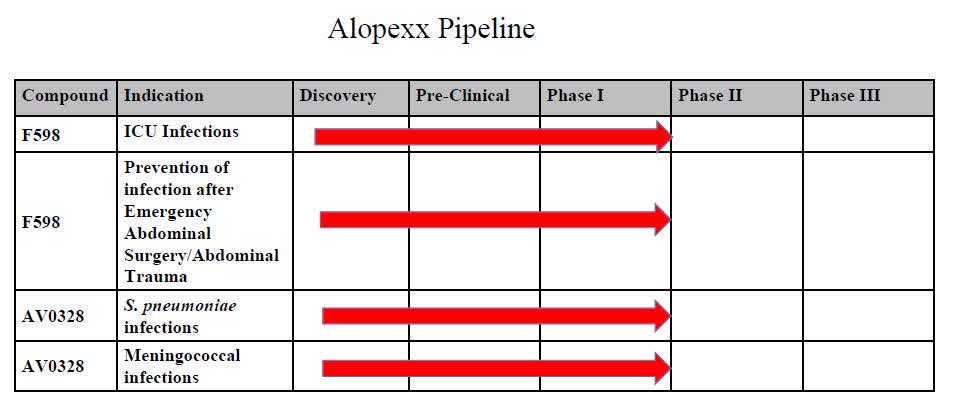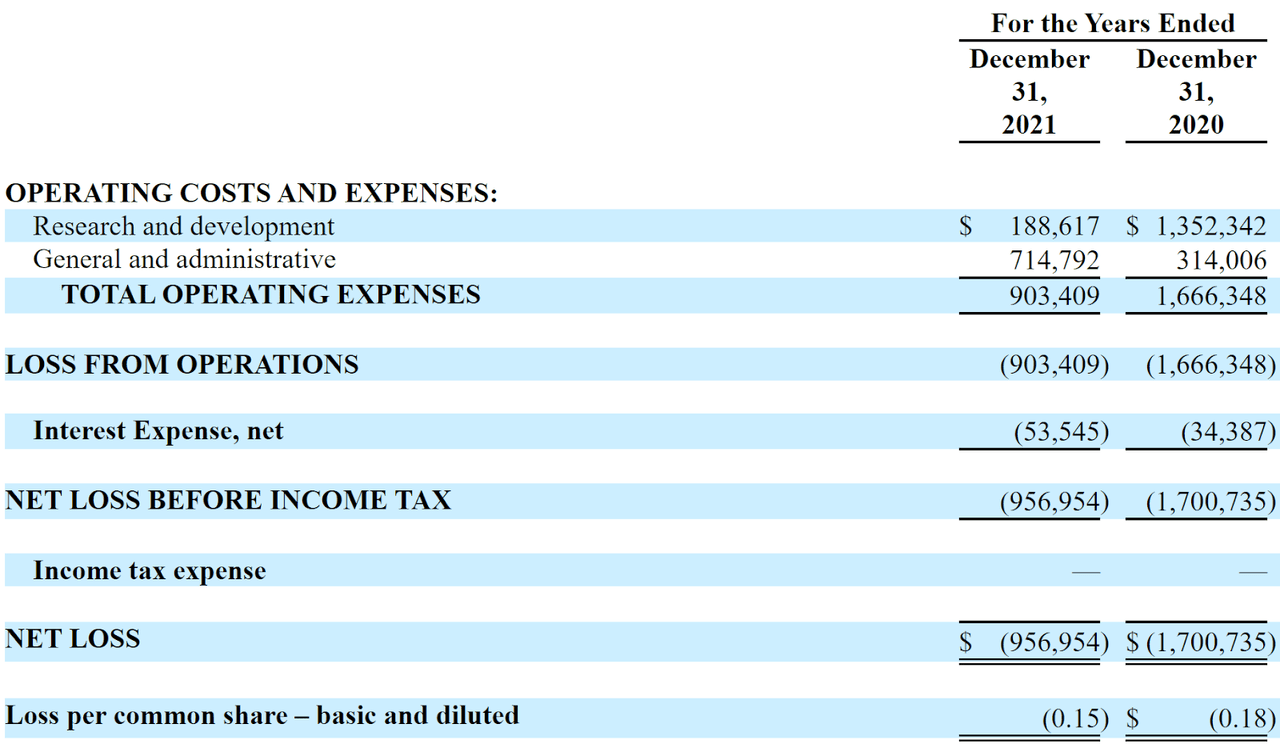Morsa Images
What Is Alopexx?
Cambridge, Massachusetts,-based Alopexx (ALPX) was founded to develop vaccines and antibodies for the prevention and treatment of fungal, parasitic and bacterial infections that express the target poly-N-acetyl glucosamine [PNAG].
Management is headed by co-founder, president and CEO Daniel R. Vlock, MD, who has been with the firm since inception and previously held senior medical and research roles at GPC Biotech, Pharmacia and Ethicon Endo-Surgery, a subsidiary of Johnson & Johnson.
The firm’s lead candidates are vaccine AV0328 for the treatment of pneumonia and meningococcal infections and F598 monoclonal antibody for the treatment of ICU acquired infections and prevention of post-operative abdominal infections.
Below is the current status of the company’s drug development pipeline:
Company Pipeline (SEC – EDGAR)
According to a 2022 market research report by Market Research Future, the global market for treating hospital acquired infections was an estimated $23.7 billion in 2020 and is forecast to reach $32.5 billion in 2030.
This represents a forecast CAGR (Compound Annual Growth Rate) of CAGR of 1.37% through 2030.
Key elements driving this expected growth are aging populations who are more susceptible to disease and the arrival of the COVID-19 pandemic driving increasing awareness of the importance of infection control.
Also, the Americas region is expected to continue to account for the greatest market demand by region, followed by Europe. The Asia Pacific region is expected to grow at the fastest rate of growth through 2030.
Major competitive vendors that provide or are developing related treatments include:
-
Pfizer
-
Merck
-
GlaxoSmithKline
-
Sanofi
-
SK Chemicals
-
Affinivax
-
Astellas
-
Several others
Alopexx’s IPO Date & Details
The initial public offering, or IPO, for Alopexx is Sept. 21, 2022, and will be available for retail investors to trade on the open market starting Sept. 22, 2022.
(Warning: Compared to stocks with more history, IPOs typically have less information for investors to review and analyze. For this reason, investors should use caution when thinking about investing in an IPO, or immediately post-IPO. Also, investors should keep in mind that many IPOs are heavily marketed, past company performance is not a guarantee of future results and potential risks may be understated.)
ALPX intends to sell 3.0 million shares of common stock at a proposed midpoint price of $5.00 per share for gross proceeds of approximately $15.0 million, not including the sale of customary underwriter options.
No existing or potentially new shareholders have indicated an interest to purchase shares at the IPO price.
Assuming a successful IPO at the midpoint of the proposed price range, the company’s enterprise value at IPO (excluding underwriter options) would approximate $27 million.
The float to outstanding shares ratio (excluding underwriter options) will be approximately 38.23%. A figure under 10% is generally considered a “low float” stock which can be subject to significant price volatility.
Per the firm’s most recent regulatory filing, it plans to use the net proceeds as follows:
approximately $5.5 million to initiate a proof-of-concept trial of vaccine AV0328, including manufacturing, and correlative laboratory studies;
approximately $4.5 million to initiate a proof-of-concept trial of our monoclonal antibody in ICU patients; and
the remainder for general corporate purposes, including working capital, operating expenses and capital expenditures, as well as potential expansion of our research pipeline.
(Source – SEC)
Management’s presentation of the company roadshow is available here until the IPO is completed.
Regarding outstanding legal proceedings, management disclosed that “On June 8, 2022, the Company was sued in the Commercial Court of Nantes, France by Xenothera. The litigation is seeking, among other things, to compel the Company to enter into a license agreement with Xenothera, or provide 120,000,000 euros in damages. No liability has been recorded related to this matter.”
How To Invest In Alopexx’ Stock: 7 Steps
Investors can buy shares of ALPX stock in the same way they may buy stocks of other publicly-traded companies.
Note: This report is not a recommendation to purchase ALPX stock or any other security. For investors who are interested in pursuing a potential investment after the ALPX IPO is complete, the following steps for buying stocks will be helpful.
Step 1: Understand Alopexx’ Financial History
Although there’s not much public information available about Alopexx, investors can look at the company’s financial history on their form S-1 or F-1 SEC filing (Source).
Step 2: Assess Alopexx’ Financial Reports
The primary financial statements available for publicly-traded companies include the income statement, balance sheet, and statement of cash flows. These financial statements can help investors learn about a company’s cash capitalization structure, cash flow trends and financial position.
The firm’s recent financial results are typical of a development stage biopharma in that they feature no revenue and material R&D and G&A expenses associated with its drug development efforts.
Below are the company’s financial results for the past two calendar years:
Statement Of Operations (SEC EDGAR)
As of June 30, 2022, the company had $421,842 in cash and $2.5 million in total liabilities.
Step 3: Evaluate Alopexx’ Potential Compared To Your Investment Horizon
When investors evaluate potential stocks to buy, it’s important to consider their time horizon and risk tolerance before buying shares. For example, a swing-trader may be interested in short-term growth potential, whereas a long-term investor may prioritize strong financials ahead of short-term price movements.
Step 4: Select A Brokerage
Investors who do not already have a trading account will begin with the selection of a brokerage firm. The account types commonly used for trading stocks include a standard brokerage account or a retirement account like an IRA.
Investors who prefer advice for a fee can open a trading account with a full-service broker or an independent investment advisor and those who want to manage their portfolio for a reduced cost may choose a discount brokerage company.
Step 5: Choose An Investment Size And Strategy
Investors who have decided to buy shares of ALPX stock should consider how many shares to purchase and what investment strategy to adopt for their new position. The investment strategy will guide an investors’ holding period and exit strategy.
Many investors choose to buy and hold stocks for lengthy periods. Examples of basic investing strategies include swing trading, short-term trading or investing over a long-term holding period.
For investors wishing to gain an allocation of shares at the IPO price, they would “indicate interest” with their broker in advance of the IPO. Indicating an interest is not a guarantee that the investor will receive an allocation of shares.
Step 6: Choose An Order Type
Investors have many choices for placing orders to purchase stocks, including market orders, limit orders and stop orders.
-
Market order: This is the most common type of order made by retail traders. A market order executes a trade immediately at the best available transaction price.
-
Limit order: When an investor places a buy limit order, they specify a maximum price to be paid for the shares.
-
Stop order: A buy-stop order is an order to buy at a specified price, known as the stop price, which will be higher than the current market price. In the case of buy-stop, the stop price will be lower than the current market price.
Step 7: Submit The Trade
After investors have funded their account with cash, they may decide an investment size and order type, then submit the trade to place an order. If the trade is a market order, it will be filled immediately at the best available market price.
However, if investors submit a limit order or stop order, the investor may have to wait until the stock reaches their target price or stop-loss price for the trade to be completed.
Commentary About Alopexx
ALPX is seeking U.S. public capital market funding to advance its pipeline of vaccine and antibody drug candidates.
The firm’s lead candidates are vaccine AV0328 for the treatment of pneumonia and meningococcal infections and F598 monoclonal antibody for the treatment of ICU acquired infections and prevention of post-operative abdominal infections.
Both candidates have proven to be well tolerated in Phase 1 safety trials. The company has recently filed a Free Writing Prospectus as a source of additional information about its activities, which can be viewed here. Source – SEC.
The market opportunity for treating hospital acquired infections is large but expected to grow at a slow rate of growth in the coming years.
Management hasn’t disclosed any major pharma firm collaboration relationships.
The company’s investor syndicate does not include any well-known life science-focused institutional venture capital firms or strategic investors.
ThinkEquity is the lead underwriter and IPOs led by the firm over the last 12-month period have generated an average return of negative (58.9%) since their IPO. This is a bottom-tier performance for all major underwriters during the period.
As for valuation, the stock will be valued at far below the typical range for a clinical stage biopharma at IPO.
While the firm has completed Phase 1 and Phase 2 proof of concept trials indicating the drugs are well tolerated, it’s still a thinly capitalized company with extensive further trials ahead, no major pharma or life science venture capital firm validation while defending itself against a potentially significant lawsuit in France.
So, I’m on Hold for the Alopexx IPO.


Be the first to comment